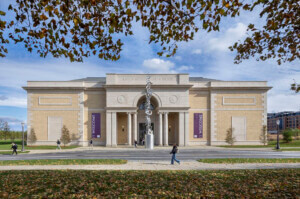Atop a tall sand dune overlooking the southern shore of Lake Michigan sits one of the last remnants of the 1933 Chicago Century of Progress World’s Fair. In severe need of restoration, the House of Tomorrow, designed by Chicago architect George Fred Keck, is set to receive an update from a team of Chicago firms.
The announcement by Indiana Landmarks named bKL Architecture as the architecture and interior design lead. Bauer Latoza Studio will offer historic preservation services and Wiss, Janney, Elstner Associates will be the structural engineer. Willoughby Engineering will handle mechanical, electrical, and plumbing engineering, and HJKessler Associates will act as the sustainability consultant.
In fall 2016, the National Trust for Historic Preservation and Indiana Landmarks launched a $2.5-million campaign to restore the house after the Trust named it a National Treasure. At the time of the fair, the house was often referred to by the media as “America’s First Glass House,” and it was a beacon of modern technology for the World’s Fair’s 39 million visitors. The glass curtain walls came nearly 20 years before both Philip Johnson’s 1949 Glass House and Mies van der Rohe’s 1951 Farnsworth House, which sits only 90 miles directly to the west. Giving a view of an optimistic future, the home focused on how science and technology could improve everyday life.
The house’s innovations include an “iceless” refrigerator, the first-ever General Electric dishwasher, and copious amounts of glass for passive solar heating. Keck would later go on to design 300 other passive solar houses, mostly in the Chicago area, throughout his long career, but the House of Tomorrow remains a standout for its uncanny design.
The 12-sided home radiates from a central hub that contains mechanical equipment. Spoke-like steel girders cantilever from the center, supporting the second and third-floor concrete slabs. This unusual structural system allows for an open floor plan, which is also rare for its time. The plan for the restoration includes removing deteriorated surfaces and revealing this steel framework. The house’s iconic glass facade will be replaced with contemporary smart glass.
The story of the House of Tomorrow after the fair is almost as eccentric as the house itself. After the closing of the World’s Fair, a Chicago developer named Robert Bartlett commissioned a fleet of barges and trucks to move the house and four other houses from the exposition to their current resting place in Beverly Shores, Indiana. Bartlett’s plan was to develop a vacation hotspot for Chicago. While this may not have worked out for him, they have become a pilgrimage point for architects and beachgoers alike as part of the Indiana Dunes National Lakeshore.
Though listed in the National Registry of Historic Places in the 1980s, the houses had fallen into severe disrepair by the 1990s. In order to save them, Indiana Landmarks was able to lease the homes from the National Parks Service and sublease four of them to individuals. Those sub-lessees were obliged to restore them, at their own expense, in exchange for long-term residency. The cost of restoration for the four houses was in excess of one million each, and the House of Tomorrow’s atypical materials and construction meant Indiana Landmarks would have to do the work itself.
But, with the naming of the restoration team and fundraising, the future of the House of Tomorrow is bright.










